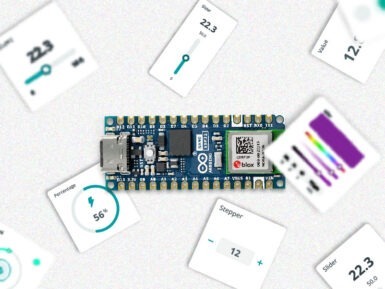
CAN-BUS Shield v2
Sold outWith its long travel distance, great communication speed and high reliability, CAN-BUS is one of the most common industrial bus.
Overview
It is commonly found on modern machine tools and as an automotive diagnostic bus.
Thanks to the CAN-BUS, makers are able to hack their cars!
It adopts MCP2515 CAN-BUS controller with SPI interface and MCP2551 CAN transceiver to give you Arduino CAN-BUS capability. Default pinout is OBD-II and CAN standard pinout can be selected by switching jumpers on DB9 interface.
Moreover, it has the TF card slot for data storage and the CS pin that can be set to D4 or D5.
The INT pin can also be set to D2 or D3 by switching jumpers on the back of the shield.
CAN-BUS Shield Works perfectly with Arduino UNO (ATmega328), Arduino Mega (ATmega1280/2560) as well as Arduino Leonardo (ATmega32U4).
Features:
-
Implements CAN V2.0B at up to 1 Mb/s
-
Industrial standard 9 pin sub-D connector
-
OBD-II and CAN standard pinout selectable.
-
Changeable chip select pin
-
Changeable CS pin for TF card slot
-
Changeable INT pin
-
Screw terminal that easily to connect CAN_H and CAN_L
-
Arduino Uno pin headers
-
2 Grove connectors (I2C and UART
-
SPI Interface up to 10 MHz
-
Standard (11 bit) and extended (29 bit) data and remote frames
-
Two receive buffers with prioritized message storage
Conformities
Get Inspired
My project has a Nodemcu ESP8266 which is controlling a 7-segment display through the http server using html form.

… remote monitoring and control. 2. Embed a web server in the device Embedding a web server inside the IoT device allows you to visualize the data using a web browser. It requires the device to have network connectivity, and it is usually implemented connecting the device to a Wi-Fi access point or with the device creating its own WiFi hotspot. Although creating your own web server implementation can be done, one of the most widespread solutions is to make use of the library ESPAsyncWebServer. It allows your IoT device to serve custom HTML pages presenting the data. This is a very flexible and customizable solution, yet complex and mostly suitable for skilled users. There are plenty of insightful examples like the following ones: ESP32 Web Server - Arduino IDE | Random Nerd TutorialsArduino Project Hub - NodeMCU ESP8266 AJAX Enabled Web Server Arduino Project Hub - WiFi Robot Car / RC Car NodeMCU Web ServerESP32 Web Server: Display Sensor Readings in Gauges | Random Nerd Tutorials The scope of this solution is typically local — you need to be on the same network as the device — although with a more advanced configuration by enabling port forwarding in the router, the device could be accessed remotely from anywhere. One of the main advantages is its low latency, as the data shown in the web page comes directly from the device without any processing. On the other hand, it is a solution that requires a high programming skill level and additionally, due to the immutable nature of the firmware, every change in a dashboard requires code recompilation and firmware reflashing. Furthermore, embedding a web server or a Bluetooth stack within the device can be resource-intensive. This may limit the device's capabilities or require a more powerful microcontroller, increasing both cost and complexity. 3. Send data to an external system with plotting capabilities IoT devices can send data to external systems using different protocols, such as







